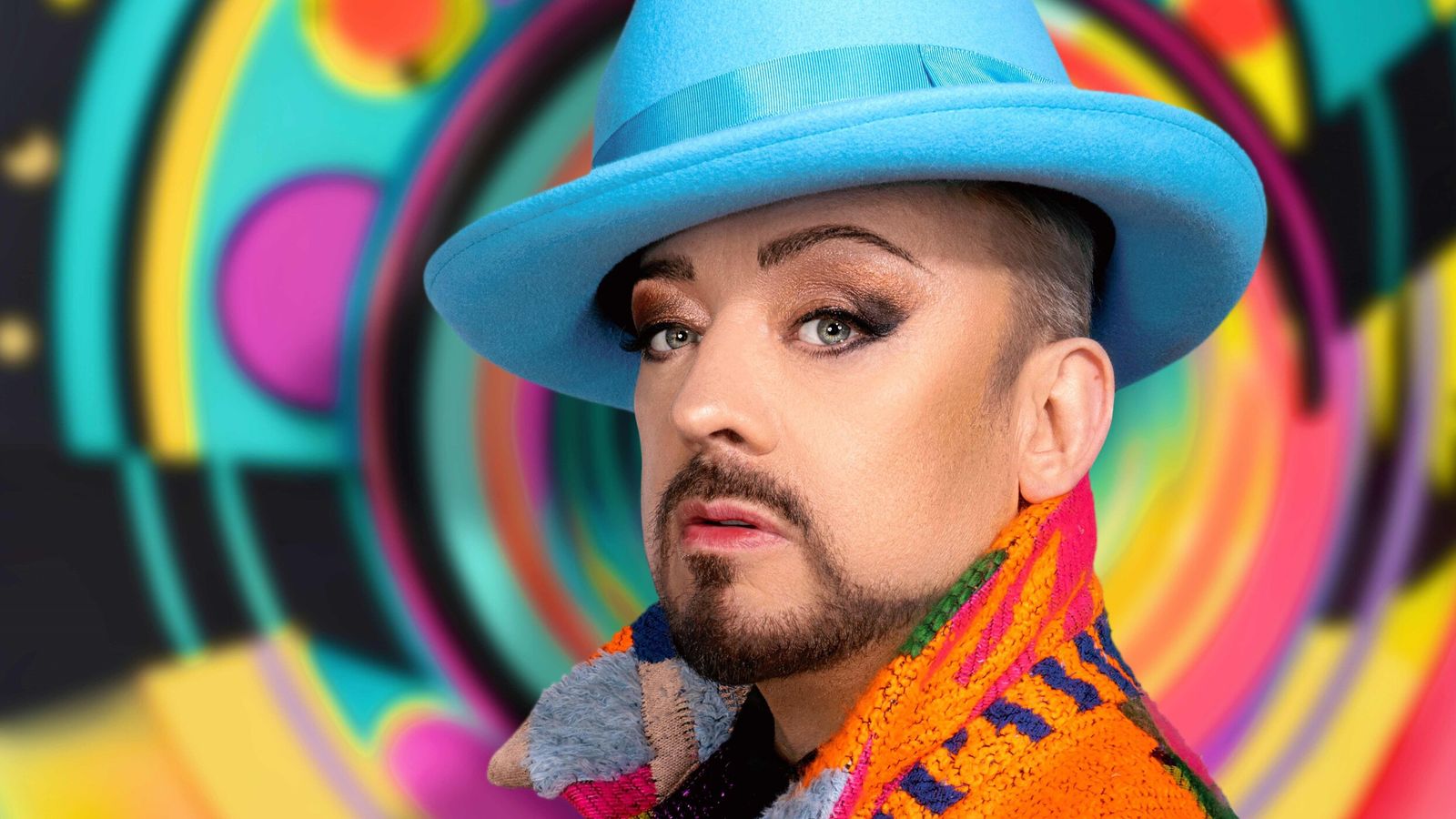Boy George on the price of fame: ‘There were moments when I lost my mind’ | Ents & Arts News
Boy George is contemplating his relationship with fame. Intoxicating, often inescapable, he says he has not always found his decades in the spotlight easy
There has been a cost, he says. Much has been well documented. But in recent years he has been able to enjoy it all much more.
And it’s not real. “Fame is a figment of other people’s imaginations. You’re only famous because other people believe you are.”
Most will know Boy George the avant garde musician, flamboyant frontman of Culture Club, one of the biggest music acts of the 1980s. Big hats, big songs, big personality. He has found new fans more recently through appearances on reality shows such as I’m A Celebrity… Get Me Out Of Here! and as a judge on The Voice.
He is also an artist, and fame is the theme of his latest collection of portraits.
Vivid, bold, punk, they are exactly as you might expect. He has painted his hero David Bowie, fellow music icons Madonna and Prince, as well as a self-portrait.
“I think of Boy George from the ’80s as a sort of cartoon character,” he says. “Because on the one hand, there was this public persona, which was one thing, and it was very recognisable. And then there was me behind it… I used to have a real problem with [fame] and I feel now I’m like, it’s just a job.”
The portrait of his younger self is a reminder of how his relationship with fame has changed.
“I never really took it that seriously,” he says. “There were moments when I lost my mind – we all know what they were. But I always kind of knew who I was.”
‘I was really lucky to have my family’
The star, whose real name is George O’Dowd, has spoken and written about his struggles with addiction in the past. In 2009, he was jailed for four months for false imprisonment.
In his last autobiography, he described it as a “stupid, aggressive and regrettable” incident that was over in “less than 30 seconds”. He disputes some of the details that came out in court, but called himself an “idiot who did too many drugs and made a massive mistake”.
George says his family helped him through the dark times. Despite there being more conversation than ever around mental health and the pressures on young stars today, he is not convinced the support is any better.
“I think in my case, I was really lucky to have my family… particularly my late mother. Whatever was going on, she was always there to kind of try and harness me into reality. And sometimes it took a bit of pulling and shoving, but I feel like my family have been so important to me in terms of, you know, keeping me sane. But it hasn’t always been an easy thing.”
Now in his 60s, as well as Boy George, he is plain old “George from Eltham”, southeast London; although plain is not really an adjective you would ascribe to him.
“As I’ve got older, I’ve kind of accepted I created this Boy George person, and I can either have as much fun with it as I can, or I can make it full of anxiety,” he says.
For his Fame collection, he chose Bowie because the artist “shaped my whole career, my whole childhood”. His relationship with Madonna, whom he has captured in her Madame X era from 2019 rather than one of her more famous earlier incarnations, “because artists continue to evolve”, is more complex.
They first met after he saw her in concert in New York, with fellow ’80s star Marilyn and two friends. They went backstage and he asked for a picture.
‘There’s never been warmth… on either side’
“She grabbed the boys and just sat them on her lap, which is kind of major,” he says. “She took control immediately. And I’ve got this great picture of Madonna and this guy that I kind of lost contact with.”
But he and the Queen of Pop never became friends. “Over the years we sort of met each other, but there’s never been any kind of warmth necessarily on either side,” he says. “But I am a fan… with me, if I like the music, I don’t necessarily have to be best friends with the person… I can like things without being petty.”
It was perhaps part and parcel of fame in the 1980s, he says.
“When you’re young, everything’s a competition. As you get older, you get a bit more confident about who you are and more secure and therefore you’re able to enjoy things without feeling threatened. So I think in the ’80s, all of us were in competition with each other… nowadays I’m kind of able to enjoy a lot of bands that I hissed at in the past, you know.”
Earlier this year, George made his Broadway debut, performing in Moulin Rouge. Now, he is getting ready for gigs with Culture Club again, alongside Tony Hadley and Heaven 17.
They will play their first two albums, Kissing To Be Clever and Colour By Numbers, in full. “[It’s] one of the reasons I agreed to this tour,” he says. “I knew we wouldn’t argue about what we were playing.”
There is also a biopic in the works. George has long said he would like Game Of Thrones star Sophie Turner to play him and the campaign continues, he says. “In this day and age, why can’t have a woman playing a man? Why not break the rules? It’s kind of what I was doing 30, 40 years ago.”
And he is still releasing solo music. His latest track, Let The Flowers Grow, is a collaboration with Bauhaus’ Peter Murphy.
“A lot of stuff I release, no one really hears of it unless they’re like a mad hardcore fan,” he says. “I’ve released 54 tracks in the last year, probably more than any other artist. And I will continue to keep putting stuff out and being creative because it feels like breathing, you know, it feels really enjoyable and I feel lucky that I get to do the thing I love.”
He takes a beat. “I mean that. I really enjoy it now in a way that I just didn’t know how to 10 years ago, 20 years ago, because I was so busy worrying about what other people thought about this, that and the other.
“Now I’m like, I want to tell people how I feel more. I mean, I’ve always done that, but I feel like, when you start to understand yourself more and realise what makes you actually happy, then you are able to express yourself in a better way.”








